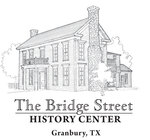

BRIDGE STREET HISTORY CENTER
Roger Enlow grew up in Granbury, graduated from Granbury High School in 1973, and worked at the Hood County News from 1976-2021. He is a member of the Bridge Street History Center Museum’s Board of Directors.
Courts Cleveland Jr. spent much of his youth exploring the wonders of Comanche Peak, Hood County's prominent landmark five miles south of Granbury. The peak held mysterious caves, wild game and artifacts left by Native Americans. There were stories of buried treasure.
The Hood County-born Cleveland often envisioned owning the majestic mountain, and his dream became reality in 1970. Cleveland has long passed, but his passion for his beloved peak is not forgotten by the stories he enjoyed sharing.
Comanche Peak (actually a mesa, flat on top) was a familiar landmark for expeditions of the Spaniards, French and Mexicans. It was also a meeting and ceremonial site for the Comanches and other Native Americans. Rising 600 feet higher than the floor of the valley, the peak offered fantastic views of herds of buffalo, deer and wild horses. The Comanches could also spot the approach of their enemies and use their science of "smoke signaling." They held victory dances on the mesa after successful raids.
"Usually when they went on raids, they left the medicine man and women camped there, and when scattered by their enemies, they all agreed to meet at this butte," Lewis Tahmahkkera, great-grandson of Comanche captive Cynthia Ann Parker, told late Hood County historian Vance Maloney.
To quell the number of Indian attacks, the U.S. government financed an expedition to Comanche Peak to negotiate a course of peace and friendliness. The chiefs were also informed that they had come under the jurisdiction of the U.S. with the entry of Texas into the Union.
"Hundreds of Indians were assembled there, heard the news as they sat in their buckskins, beads, paint and feathered finery, on top of this noted landmark," Maloney wrote in "The Story of Comanche Peak ... Landmark of Hood County, Texas." "The pipe of peace smoke signals began rising at Comanche Peak, and thus played an important part in the history of Texas."
Early peak owners were lenient with curious visitors such as the young Cleveland, but a later owner objected to hikers wandering on his private property. He sent word to boys in town that he had a shotgun and would shoot anything moving. Only the bravest ... or slowest-thinking ... youngsters risked exploring the peak.
Cleveland sometimes invited the public for tours. "And visitors had no difficulty believing that Indians once held sway on the peak, judging from the scattered chips of worked flint they occasionally spotted on the ground," the late Hood County News writer Leland DeBusk wrote.
Visitors enjoyed spotting the familiar Granbury landmarks below in the distance -- the courthouse, Lake Granbury. They were also fascinated with the names and dates carved in the flat rocks on the mesa. Some date back to the 1800s.
The caves have always been a source of intrigue. A pioneer once claimed to have ventured into one of the caves with 600 feet of trotline to keep from losing his way. He reported finding an underground river so wide he could not cross it. One of the previous landowners kept losing his goats because they would wander into the caves. He solved the problem by dynamiting the entrances.
Did the landowner seal something valuable? Cleveland told the story of soldiers escorting several muleloads of gold before being ambushed by Indians. The soldiers were able to hide the gold before they were all killed. People have searched and searched, but they can't find the treasure, Cleveland said.
A state historical marker about Comanche Peak stands on Highway 144 in the shadows of the peak. It reads, "Prominent Indian and pioneer landmark. Actually a mesa, the peak rises 1,229 feet (above sea level). May have had ceremonial value for local tribes or have been a look-out point for game and enemies. A Comanche trail crossed county in this vicinity. In 1846 whites and Indians en route to the so-called 'peak' for a meeting almost failed to find it because of its flat top. Later settlers held dances here and students from Add-Ran College (about 10 miles N) had picnics at the peak. Boys also hunted wolves and rattlesnakes among caves and rocks on the top."